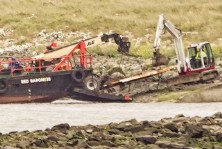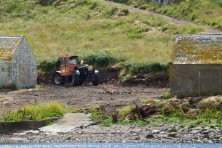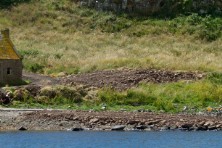Arctic Tern on Pladda
Reports

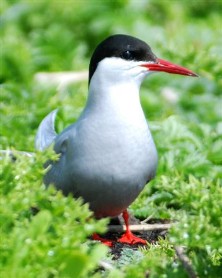
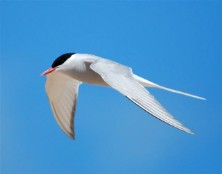
Arctic Tern is one of six species of tern which have been recorded on Arran, but it is the only one that breeds here. Up to the end of the twentieth century, there was a colony on the west coast of Arran and one on Pladda. The last confirmed breeding on the west coast was at Dougarie in 2003. Now only the colony on Pladda remains.
Arctic Terns are famous for undertaking the longest migration of any bird. One bird ringed as a chick on the Farne Islands off the northeast coast of England in June 1982 turned up in Melbourne, Australia, 22,000km by sea, in the October. Some individuals travel from the Arctic to the Antarctic and back again over the course of a year, a distance of around 40,000km. Their migration means that they never feel the full effects of winter - when the northern hemisphere experiences its winter months, the birds are in the southern hemisphere, and vice versa. Arctic Terns breed in northern latitudes such as the UK, as well as in the Arctic circle. They are long lived birds with some known to be over thirty years old, so the lifetime travel distances are huge. A remarkable bird that sees more daylight than any other species.
Primarily a marine species throughout its world range, in Scotland most breeding colonies are on the coast, often on small rocky isles and skerries but also on the shores of larger islands and the mainland. The strongholds of Arctic Tern are in Orkney and Shetland where some colonies hold thousands of pairs. Between the British Trust for Ornithology Breeding Atlas of 1968-72 and the most recent British Trust for Ornithology Breeding Atlas of 2008-2011 the breeding population of Arctic Tern in the British Isles decreased by 31%. Losses are greatest in western Scotland, where predation by American Mink has been implicated, and in eastern Scotland, where food shortages have resulted in very low breeding productivity. To try to conserve Arctic Tern the species is Amber Listed and protected.
Here on Arran, there are meticulous records collected by the bird recorders of the Arran Natural History Society and members of the Clyde Bird Ringing Group stretching back fifty years, all with the support of previous owners. In 1975 fifteen pairs bred on Pladda, in 1976 twenty-eight pairs and in 1977 forty-three pairs. Throughout the rest of last century there were similar numbers, but they can be fickle, for example in 1991 the colony of seventeen pairs deserted due to disturbance from humans with dogs. The Pladda colony has continued successfully throughout this century. Recent records include fourteen breeding adults in July 2020 and twelve breeding adults in June 2021. Nesting on Pladda was not checked in 2022 and 2023 because of avian flu restrictions but Arctic Terns were present. Similarly, this year Arctic Tern were reported to be on Pladda between 24 May and 12 June, holding territory preparing to breed.
On Monday 1 July 2024, as shown in the first photograph, contractors with earth moving machinery moved onto Pladda. While I have no idea what the intention was, the result was that the pebbly area close to the landing area to the right of the jetty where historically Arctic Tern had bred was almost entirely covered in dumped soil and turf. The second photo showing the jetty and the area was taken on Sunday 7 July. This disturbance of breeding birds has been reported to Police Scotland. On Monday 8 July there was a report of one Arctic Tern flying over Pladda. With the activity of the previous week, it is unlikely that Arctic Tern will breed on Pladda this year.
What about the future of Pladda and the future of Arctic Tern on Pladda?
On Thursday 29 August 2024 at 6.00pm in Kildonan Hotel, Michael O’Sullivan, the new owner of Pladda will share his vision for Pladda. He “very much looks forward to meeting and listening to our village community. The architects Denham Youd of Ayr , who have worked on several projects on Arran , will also be there to hear views and answer questions”. From the documents that have been put in the public domain ( 24_00530_EIA-PRE_APPLICATION_DESIGN_STATEMENT-1226789.pdf https://www.eplanning.north-ayrshire.gov.uk/OnlinePlanning/files/674589226BC3B89916ECC9B72113C465/pdf/24_00530_EIA-PRE_APPLICATION_DESIGN_STATEMENT-1226789.pdf ), there is no mention of Arctic Tern, no mention of any of the Red or Amber Listed bird species that currently breed on Pladda, no mention of any bird, fauna or flora on this special island that sits in the South Marine Arran Protection Area.
This remarkable bird, the Arctic Tern, with its long tail streamers and buoyant flight has for a long time graced the shores on the south of Arran, plunging into the sea for sand eels to feed its young. Will it do so in the future? The responsibility for that lies with all of us including the landowner, architects, planners, and contractors, as well as wildlife enthusiasts. Without collective support this spectacle will become a fading memory and Arran will be a poorer place.
(Note: The photographers of the Arctic Tern are by Dennis Morrison. The first photo of the machinery on Pladda is by Joan Thomson and the other two of Pladda are by Stephen Garraway.)
For more information on "The importance of Pladda" click here.
